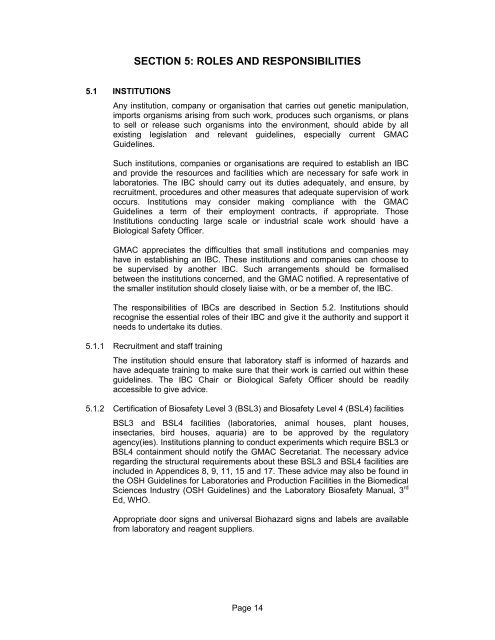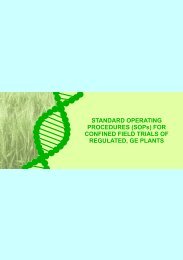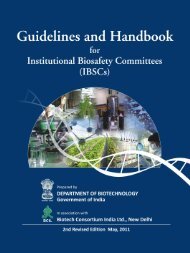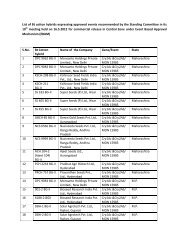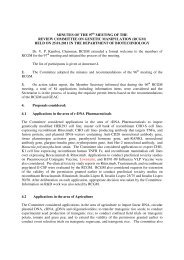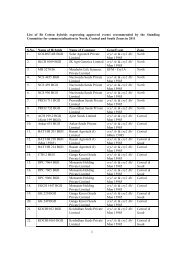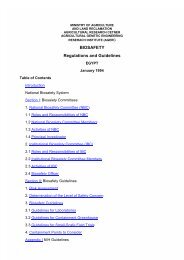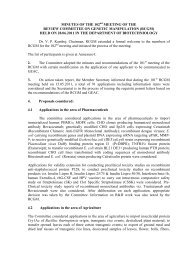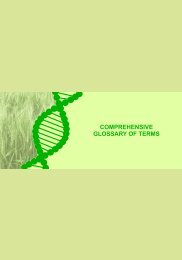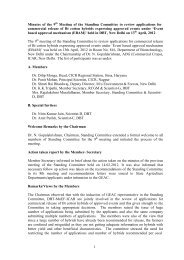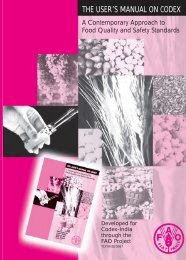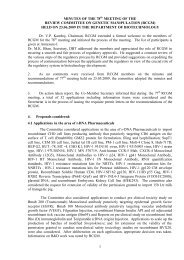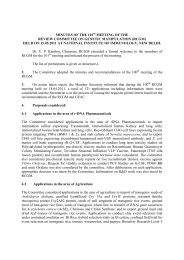Biosafety Guidelines For Research On Genetically Modified ...
Biosafety Guidelines For Research On Genetically Modified ...
Biosafety Guidelines For Research On Genetically Modified ...
Create successful ePaper yourself
Turn your PDF publications into a flip-book with our unique Google optimized e-Paper software.
SECTION 5: ROLES AND RESPONSIBILITIES<br />
5.1 INSTITUTIONS<br />
Any institution, company or organisation that carries out genetic manipulation,<br />
imports organisms arising from such work, produces such organisms, or plans<br />
to sell or release such organisms into the environment, should abide by all<br />
existing legislation and relevant guidelines, especially current GMAC<br />
<strong>Guidelines</strong>.<br />
Such institutions, companies or organisations are required to establish an IBC<br />
and provide the resources and facilities which are necessary for safe work in<br />
laboratories. The IBC should carry out its duties adequately, and ensure, by<br />
recruitment, procedures and other measures that adequate supervision of work<br />
occurs. Institutions may consider making compliance with the GMAC<br />
<strong>Guidelines</strong> a term of their employment contracts, if appropriate. Those<br />
Institutions conducting large scale or industrial scale work should have a<br />
Biological Safety Officer.<br />
GMAC appreciates the difficulties that small institutions and companies may<br />
have in establishing an IBC. These institutions and companies can choose to<br />
be supervised by another IBC. Such arrangements should be formalised<br />
between the institutions concerned, and the GMAC notified. A representative of<br />
the smaller institution should closely liaise with, or be a member of, the IBC.<br />
The responsibilities of IBCs are described in Section 5.2. Institutions should<br />
recognise the essential roles of their IBC and give it the authority and support it<br />
needs to undertake its duties.<br />
5.1.1 Recruitment and staff training<br />
The institution should ensure that laboratory staff is informed of hazards and<br />
have adequate training to make sure that their work is carried out within these<br />
guidelines. The IBC Chair or Biological Safety Officer should be readily<br />
accessible to give advice.<br />
5.1.2 Certification of <strong>Biosafety</strong> Level 3 (BSL3) and <strong>Biosafety</strong> Level 4 (BSL4) facilities<br />
BSL3 and BSL4 facilities (laboratories, animal houses, plant houses,<br />
insectaries, bird houses, aquaria) are to be approved by the regulatory<br />
agency(ies). Institutions planning to conduct experiments which require BSL3 or<br />
BSL4 containment should notify the GMAC Secretariat. The necessary advice<br />
regarding the structural requirements about these BSL3 and BSL4 facilities are<br />
included in Appendices 8, 9, 11, 15 and 17. These advice may also be found in<br />
the OSH <strong>Guidelines</strong> for Laboratories and Production Facilities in the Biomedical<br />
Sciences Industry (OSH <strong>Guidelines</strong>) and the Laboratory <strong>Biosafety</strong> Manual, 3 rd<br />
Ed, WHO.<br />
Appropriate door signs and universal Biohazard signs and labels are available<br />
from laboratory and reagent suppliers.<br />
Page 14


